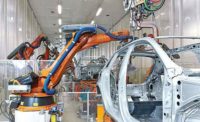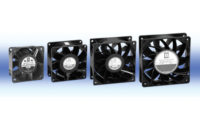At a recent Fabtech convention, many visitors to our booth told us the same thing: “We’d really like a large fan in our facility, but we can’t—we weld.”
It’s a common belief that airflow from large, overhead fans disperses shielding gases, which can lower weld quality. But, by avoiding industrial fans altogether, facilities could be missing out on more than just summer cooling—fans can also help disperse welding fumes, control condensation and reduce heating costs in winter by pushing heat back toward the floor.
While it’s true that fans can disperse shielding gases, it’s by no means a certainty. Thousands of welding facilities have installed fans successfully. It simply required a few more steps and a little more expertise than installing a ceiling fan in, say, a dry-goods warehouse or a living room.
It’s all about finding the sweet spot—the combination of fan speed, fan size and adequate distance from the welding area—to achieve a cooling airflow without blowing away shielding gases. However, because no two facilities are alike, there is no one-size-fits-all solution. The ideal type, size and speed of a fan will vary based on factors such as the facility’s dimensions and layout, and what type of welding is being done.
For example, at the request of a major manufacturer of earth movers and farm equipment, extensive testing by our research and development team showed that the manufacturer could run 18-foot fans at 60 to 70 percent of maximum speed without affecting shielding gases in their welding facility. At that speed, the fans still provided enough airflow to create approximately 5 to 7 degrees of perceived cooling for employees. That customer has since bought some 60 fans from us.
However, in a smaller facility where the only viable mounts for overhead fans were bar joists directly over the welding bays, installing overhead high-volume, low-speed (HVLS) fans proved problematic. In that case, the presence of numerous I-beams meant variable-speed directional fans could be mounted so that they delivered the correct airflow without disrupting gas delivery.
The best way to guarantee that HVLS fans will work in a welding facility is to enlist the help of a fan company with an applications engineering team that can provide custom fan layouts accounting for all variables. In complex situations, a mobile team of engineers can be called in to perform on-site measurement and evaluation.
While no two situations are alike, the following tips will help welding facilities get the right fan.
Variable Speed Controls
One of the most important technologies for guaranteeing a fan won’t disperse shielding gas and increase weld porosity is a variable speed control. Also known as infinite speed controls, these devices allow the user to set a speed anywhere from 1 to 100 percent of the fan’s maximum speed.
Most column-mounted fans, and even some HVLS fans, are equipped only with the same speed options as a common residential ceiling fan: high, medium and low. This can limit installations in industrial facilities. For example, medium speed could be too low to produce a cooling breeze, while high speed could be too powerful, dispersing shielding gases.
The trick in welding facilities is to find a speed powerful enough to cool people off, but light enough not to disperse the gas. Variable speed controls are often the only way to achieve that ideal speed.
Speed Limit Enforcement
As any office manager knows, if you tell employees not to adjust a thermostat, that’s the first thing they’ll do. The same holds true with industrial fan controls. It’s hard to blame employees. Comfort is personal, and working in uncomfortable conditions is no fun.
Fan manufacturers should offer the ability to limit the speed of the fan. In the case of our customer, the heavy-equipment manufacturer, 70 percent of maximum speed provided the ideal airspeed, so Big Ass Fans limited the fans to 70 percent. That prevented uncomfortable employees from dialing up the speed and potentially dispersing shielding gases inadvertently.
Proper Fan Placement
Installing a fan directly over a welding area will almost always affect shielding gases. However, many facilities managers who have resisted HVLS fans don’t realize that a fan needn’t be directly overhead to provide cooling airflow.
Much of the breeze from an HVLS fan isn’t a result of air being pushed downward by the fan. Rather, it’s from air that impacts the floor and flows outward, creating what’s known as a floor jet.
To have the smallest impact possible on shielding gases, fans should be installed away from the welding area, giving the floor jets enough space to slow down before reaching the welding station. At the correct distance, the fans can provide all their normal benefits—year-round thermal comfort and improved air circulation—while floor jets can even send a few degrees of cooling to welding technicians.
Education on Other Options
Occasionally, it’s simply impossible to install an overhead fan without affecting welding gases, and any company that claims otherwise is misleading the customer. In those cases, large mobile and column-mounted fans can provide a more direct airflow.
Again, it’s important that these fans include variable speed controls—most portable and column-mounted fans don’t—because ricochet air jets can still interrupt the welding process without careful speed control.
For more information, call 877-BIG-FANS or visit www.bigassfans.com.



